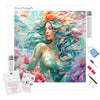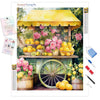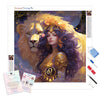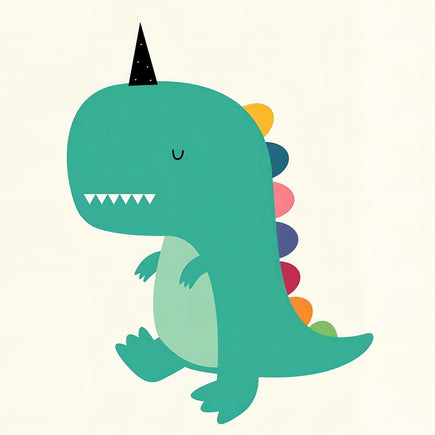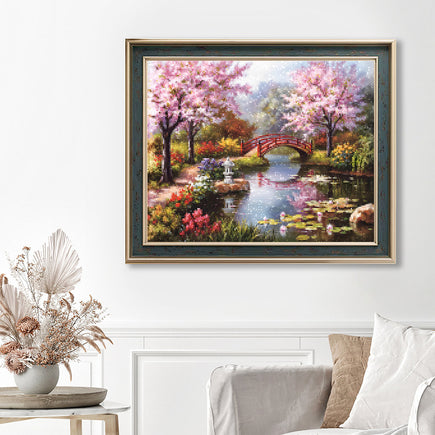How to Repair Your Diamond Painting Canvas
Every diamond painter has their moment of disaster: the cat or dog jumps on the table, the child bumps the canvas with a toy, or somehow, the finished canvas has gotten bent in storage. That awful feeling of seeing your hours of painstaking work has been compromised is horrible - but don't panic.
The great news is that diamond paintings are incredibly durable! This guide will cover just the most common types of canvas damage and how to restore your sparkle and protect your beautiful piece.

1. Repairing Bumps, Wrinkles, and Creases
These accidents usually happen when the canvas is dropped, folded by a child, or bent during transport. So how should we flatten the canvas?
Solution A: Flattening with Pressure (Safest)
This is the gentlest method for fixing kinks and folds in the canvas material.
Prep: Lay your damaged canvas perfectly flat on a clean, hard surface.
Apply Weight: Place a stack of heavy, flat objects (large books or heavy boxes) evenly across the entire surface of the canvas.
Wait: Leave the weights on the canvas for 24 to 48 hours. The constant, prolonged pressure will naturally relax the canvas material and smooth out most creases without heat.
Solution B: Ironing Out Stubborn Folds (Post-Completion)
Use this method for severe creases, especially on finished sections.
Set Up: Turn your iron to the lowest heat setting possible and turn the steam OFF.
Protect the Canvas: Place a thick towel or a piece of parchment paper over the drilled side of the canvas.
Apply Heat: Gently press the iron over the towel, focusing on the creased area. The indirect, low heat will relax the vinyl backing and flatten the canvas without melting the drills on the front.
2. Restoring Lost Adhesion
This type of damage is usually caused by pet hair or debris falling onto the exposed adhesive. In this case, we should first clean the diamond painting canvas.
Solution A: Cleaning Debris
Should the adhesive be covered with lint, it will not bond, so please don't scrape it off!
Tape Lift: Take some wide, clear packing tape, or a low-tack lint roller, and gently place the adhesive side of the tape onto the area and lift it off. The debris will come up without pulling the original glue off the canvas.
Tweezers for Strays: Using a sharp pair of tweezers, carefully remove any annoying hair or lint stuck in the glue.
Solution B: Repairing Dried or Scraped Glue
For cases when all of the adhesive has been scraped off, or dried due to exposure:
Clear Glue Dab (Small Spots): If there is only a small hole in the adhesive, use a toothpick to apply a small amount of clear water-based craft glue (such as Mod Podge) directly to the canvas, or apply mini glue to the hole. Once it becomes slightly sticky, you can attach the drill.
Double-Sided Tape (Large Patches): If you have a large damaged patch, you can cut a piece of thin, clear double-sided adhesive craft tape to cover the area and make a new layer. The new tape creates a fresh, clean, and strong adhesive layer to drill directly onto.

3. Repairing Physical Rips and Tears
This addresses tears in the canvas fabric itself, usually caused by rough handling or a serious accident.
Solution: Reinforcing the Backing
If the canvas fabric is ripped, it must be backed to hold its tension and flatness.
Turn Over: Flip the canvas over so the non-adhesive side is up.
Back the Rip: Take a length of strong duct tape or wide clear packing tape and apply it firmly across the rip. Make sure the tape extends well beyond the rip on all sides.
Why it Works: Taping the back restores the integrity of the canvas material and prevents the rip from spreading without too much effect on the sticky surface or drills on the front.
4. Replacing Lost or Missing Drills
Drill missing? Whether they fell off a finished piece or were accidentally picked out by a curious child, replacing the stone restores the visual uniformity.
Solution: Replacement drills
Find the Match: Find the color code of the missing drill bit according to the illustration, and then use the 30% of drill bits reserved for you in the Diamond Painting Pro Toolkit to select the same drill and paste it.
Secure the New Drill: If the empty square is dry, use a tiny dab of clear craft glue with a toothpick before placing the replacement drill.
Restore Uniformity: Immediately placing the new, matching drill will seamlessly blend the repair into the surrounding design.
5. Prevention is the Ultimate Fix
Accidents happen, but these habits will significantly reduce the risk of future damage:
Sealing Your Finished Art: After finishing a diamond art painting, it is optimal to seal it with a clear, glossy sealant (especially if hanging or storing.) This helps to lock every drill or bead in place which will provide the most durable finish to the entire surface for small scuffs. In addition, framing your completed piece in a timely manner is also a good protective measure.
The "Adhesive Out" Rule: When rolling your completed or in-progress canvas, it is advisable to always roll the canvas with the drills/adhesive facing OUT. This technique prevents the canvas from curling back toward itself, which could create creases that can ruin your work.
Find a Safety Zone: If you are able to, and if your space permits, find a clear, higher work area (or use an easel) to keep your canvas out of the way when you leave the room. This helps manage the most common types of accidental damage caused by kids or pets running around.

Don't Let Accidents Win!
Repairing your canvas doesn't require special skills or tools. Just a few minutes of focused effort using these tricks, like a tiny dab of glue or strategic tape placement, is all it takes to completely rescue your project and restore its flawless shine.
Now that you have the knowledge to repair imperfections in diamond-painted canvas, there's nothing stopping you from embarking on a new, ambitious project.



